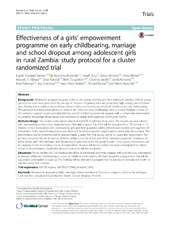| dc.contributor.author | Sandøy, Ingvild Fossgard | en_US |
| dc.contributor.author | Mudenda, Mweetwa | en_US |
| dc.contributor.author | Zulu, Joseph | en_US |
| dc.contributor.author | Munsaka, Ecloss | en_US |
| dc.contributor.author | Blystad, Astrid | en_US |
| dc.contributor.author | Makasa, Mpundu | en_US |
| dc.contributor.author | Mæstad, Ottar | en_US |
| dc.contributor.author | Tungodden, Bertil | en_US |
| dc.contributor.author | Jakobs, Choolwe | en_US |
| dc.contributor.author | Kampata, Linda Milimo | en_US |
| dc.contributor.author | Fylkesnes, Knut | en_US |
| dc.contributor.author | Svanemyr, Joar | en_US |
| dc.contributor.author | Moland, Karen Marie | en_US |
| dc.contributor.author | Banda, Richard | en_US |
| dc.contributor.author | Musonda, Patrick | en_US |
| dc.date.accessioned | 2017-08-03T12:05:53Z | |
| dc.date.available | 2017-08-03T12:05:53Z | |
| dc.date.issued | 2016-12-09 | |
| dc.identifier.issn | 1745-6215 | |
| dc.identifier.uri | https://hdl.handle.net/1956/16197 | |
| dc.description.abstract | Background: Adolescent pregnancies pose a risk to the young mothers and their babies. In Zambia, 35% of young girls in rural areas have given birth by the age of 18 years. Pregnancy rates are particularly high among out-of-school girls. Poverty, low enrolment in secondary school, myths and community norms all contribute to early childbearing. This protocol describes a trial aiming to measure the effect on early childbearing rates in a rural Zambian context of (1) economic support to girls and their families, and (2) combining economic support with a community intervention to enhance knowledge about sexual and reproductive health and supportive community norms. Methods/design: This cluster randomized controlled trial (CRCT) will have three arms. The clusters are rural schools with surrounding communities. Approximately 4900 girls in grade 7 in 2016 will be recruited from 157 schools in 12 districts. In one intervention arm, participating girls and their guardians will be offered cash transfers and payment of school fees. In the second intervention arm, there will be both economic support and a community intervention. The interventions will be implemented for approximately 2 years. The final survey will be 4.5 years after recruitment. The primary outcomes will be “incidence of births within 8 months of the end of the intervention period”, “incidence of births before girls’ 18th birthday” and “proportion of girls who sit for the grade 9 exam”. Final survey interviewers will be unaware of the intervention status of respondents. Analysis will be by intention-to-treat and adjusted for cluster design and confounders. Qualitative process evaluation will be conducted. Discussion: This is the first CRCT to measure the effect of combining economic support with a community intervention to prevent adolescent childbearing in a low- or middle-income country. We have designed a programme that will be sustainable and feasible to scale up. The findings will be relevant for programmes for adolescent reproductive health in Zambia and similar contexts. | en_US |
| dc.language.iso | eng | eng |
| dc.publisher | BioMed Central | eng |
| dc.rights | Attribution CC BY | eng |
| dc.rights.uri | http://creativecommons.org/licenses/by/4.0 | eng |
| dc.subject | Adolescent pregnancy | eng |
| dc.subject | Early marriage | eng |
| dc.subject | School enrolment | eng |
| dc.subject | Economic support | eng |
| dc.subject | Community dialogue | eng |
| dc.subject | Cash transfer | eng |
| dc.subject | Sexual and reproductive health | eng |
| dc.subject | School dropout | eng |
| dc.subject | Poverty | eng |
| dc.title | Effectiveness of a girls’ empowerment programme on early childbearing, marriage and school dropout among adolescent girls in rural Zambia: study protocol for a cluster randomized trial | en_US |
| dc.type | Peer reviewed | |
| dc.type | Journal article | |
| dc.date.updated | 2016-12-29T12:45:56Z | |
| dc.description.version | publishedVersion | en_US |
| dc.rights.holder | Copyright 2016 The Author(s) | |
| dc.source.articlenumber | 588 | |
| dc.identifier.doi | https://doi.org/10.1186/s13063-016-1682-9 | |
| dc.identifier.cristin | 1416792 | |
| dc.source.journal | Trials | |
| dc.source.40 | 17 | |

